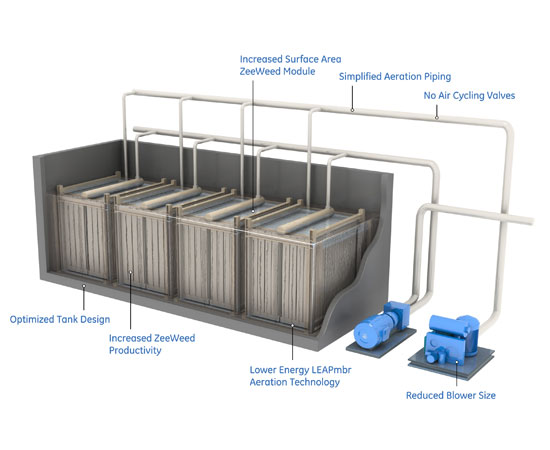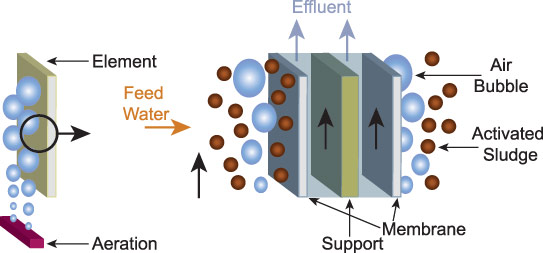How Membrane Bioreactor Technology Is Revolutionizing Wastewater Treatment
How Membrane Bioreactor Technology Is Revolutionizing Wastewater Treatment
Blog Article
Membrane Bioreactors Clarified: Efficient Solutions for Clean Water
Membrane layer bioreactors (MBRs) have arised as an advanced remedy for addressing the pushing difficulties of wastewater treatment - Membrane Bioreactor. By integrating biological processes with advanced membrane filtering, MBRs not only boost the high quality of treated water but also lower the spatial needs of therapy facilities.

What Are Membrane Bioreactors?
Membrane bioreactors (MBRs) are sophisticated wastewater treatment systems that integrate organic degradation processes with membrane layer purification modern technology. This integration allows for the reliable removal of impurities from water, making MBRs a preferred option in various applications, consisting of community wastewater treatment and industrial effluent administration.

One of the important advantages of MBRs is their capability to create top quality effluent, frequently suitable for reuse in watering or commercial procedures. Furthermore, MBRs require a smaller sized impact compared to conventional treatment systems, making them ideal for city settings where room might be limited.
Furthermore, MBRs can efficiently take care of differing influent loads and are much less vulnerable to the results of toxic shocks. These features contribute to their expanding appeal as a lasting remedy for resolving the boosting demand for tidy water while reducing ecological impacts.
Just How Membrane Layer Bioreactors Job
While the procedure of membrane layer bioreactors (MBRs) might seem facility, it basically focuses on the synergy in between organic procedures and membrane filtration. MBRs incorporate a biological treatment process, generally activated sludge, with a membrane layer separation system to deal with wastewater effectively.
In an MBR system, wastewater is very first introduced right into a bioreactor where microbes weaken raw material and other contaminants. The biological activity reduces the concentration of pollutants while promoting the development of biomass. Following this organic therapy, the combined liquor goes through membrane layer filtering, which can be microfiltration or ultrafiltration, depending upon the preferred effluent high quality.
The membranes function as a physical barrier, allowing water and small solutes to pass while retaining put on hold solids and bigger particles. This allows the system to preserve a high concentration of biomass within the reactor, boosting the therapy effectiveness.
Additionally, the constant separation of cured water from the biomass promotes a small style and reduces the footprint of the therapy facility. In general, the mix of organic deterioration and membrane purification in MBRs causes dependable and effective wastewater therapy, making sure top notch effluent ideal for different applications.
Benefits of MBR Technology
Among the key advantages of membrane layer bioreactor (MBR) innovation is its capacity to create high-quality effluent with a significantly lowered footprint contrasted to traditional wastewater treatment techniques. MBR systems effectively incorporate biological therapy and membrane filtering, resulting in remarkable removal of pollutants, consisting of suspended solids, virus, and organic issue. This capability causes effluent that frequently fulfills or surpasses rigid regulatory requirements for reuse and discharge.
Additionally, MBR innovation permits higher biomass concentrations, which boosts the treatment effectiveness and lowers the needed activator quantity. This compact style is specifically advantageous in city locations where space is limited. The functional adaptability of MBR systems also implies they can adapt to differing influent top qualities and flow rates, making them appropriate for a vast array of applications.
In addition, the decreased sludge manufacturing associated with MBR procedures adds to decrease functional and upkeep prices. The membranes offer as a physical obstacle, minimizing the risk of blocking and allowing longer functional periods between cleaning. Overall, the advantages of MBR modern technology make it an attractive service for sustainable wastewater treatment, attending to both ecological worries and the demand for reliable source monitoring.
Applications of Membrane Layer Bioreactors
With their convenience and performance, membrane layer bioreactors (MBRs) locate applications throughout different markets, consisting of local wastewater treatment, industrial processes, and even water reclamation. In metropolitan setups, MBRs give a small option for treating wastewater, efficiently removing contaminants while simultaneously generating high-grade effluent that fulfills rigid regulative standards. This makes them particularly ideal for locations with restricted space.
In commercial applications, MBR innovation is utilized for dealing with procedure water, especially in industries such as food and drink, pharmaceuticals, and petrochemicals. These sectors benefit from MBRs' capability to take care of high natural loads and their effectiveness in recouping useful resources from wastewater, such as nutrients and water.
Moreover, MBRs play a critical function in water reclamation efforts, allowing the reuse of dealt with wastewater for irrigation, industrial procedures, or perhaps as drinkable water after more therapy (Membrane Bioreactor). Their performance in removing pollutants and virus makes them a reputable option for making sure water quality in different reuse applications
Future of Water Treatment Solutions
The future of water treatment remedies is poised for transformative advancements driven by technical technology and raising ecological recognition. As global water shortage comes to be a pressing concern, brand-new approaches, consisting of membrane bioreactor (MBR) systems, are set to play a crucial role in improving the performance and sustainability of water treatment processes.
Arising modern technologies such as synthetic knowledge and artificial intelligence are anticipated to maximize therapy procedures, enabling real-time tracking and predictive upkeep. This will certainly improve the overall integrity and performance of water therapy centers. Innovations in membrane layer materials, such as look at this now graphene and nanofiltration, guarantee to raise permeation rates and lower fouling, leading to lower energy usage and functional expenses.
Additionally, the combination of renewable resource sources right into water treatment plants will certainly add to greener practices. The round economic situation version will certainly also acquire traction, urging the healing of valuable sources from wastewater, such as nutrients and power.
Final Thought

Membrane bioreactors (MBRs) have actually emerged as an innovative option for resolving the pushing obstacles of wastewater treatment. By incorporating organic processes with innovative membrane layer filtration, MBRs not just enhance the top quality of treated more tips here water but likewise lower the spatial requirements of therapy centers.One of the crucial advantages of membrane layer bioreactor company website (MBR) innovation is its capability to generate top notch effluent with a significantly decreased footprint compared to conventional wastewater treatment methods.With their adaptability and performance, membrane layer bioreactors (MBRs) find applications throughout different fields, consisting of local wastewater treatment, industrial processes, and also water reclamation.In verdict, membrane layer bioreactors represent a substantial innovation in wastewater treatment innovation, integrating organic processes with effective membrane layer filtering to create top notch effluent.
Report this page